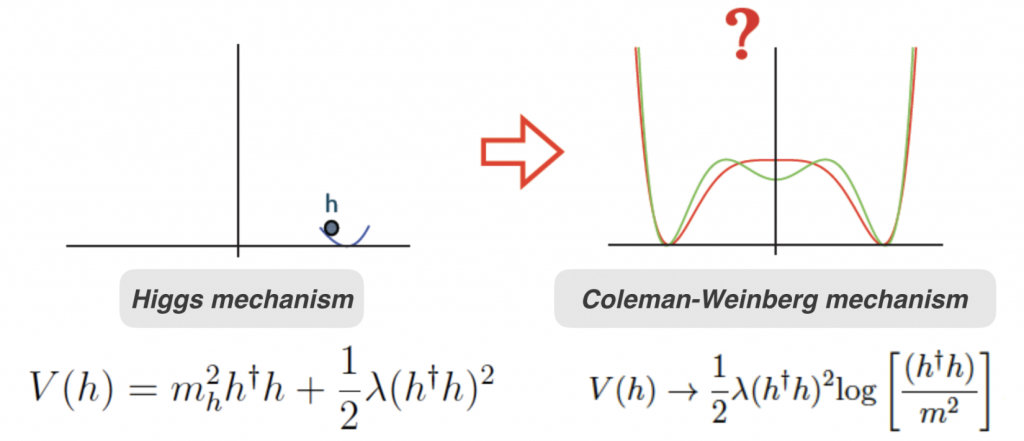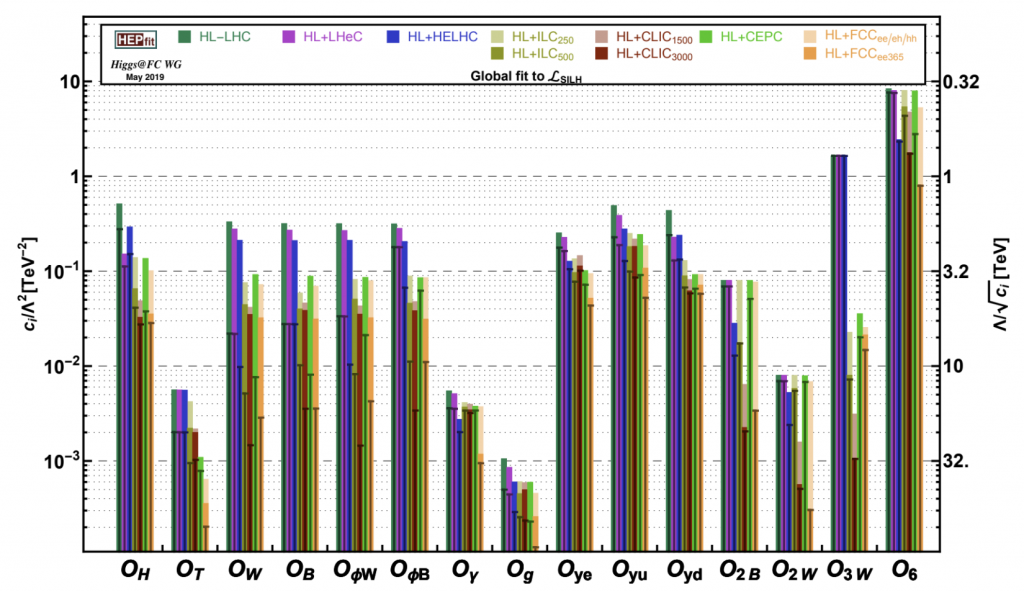This is a reblog from Juan Rojo’s own blog: https://juanrojo.com
When discussing about the various options concerning the future of particle physics, in particular in the context of the Update of the European Strategy for Particle Physics, the Higgs boson plays certainly a most important role. The Higgs is truly a unique beast, whose mysterious properties we have just started to unveil. Therefore, also motivated by some recent discussions on Twitter, I though it would be appropriate to write something about why moving forward with the ongoing charting of the Higgs boson sector should be the cornerstone for any future development in particle physics, and in particular why such study is immensely more important for our fundamental understanding of Nature, and represents a much higher goal than a mere bureaucratic rubber-stamping of the Standard Model.
Let me try to motivate why the Higgs boson is a particle like no one humankind has ever encountered before. To begin with, the Higgs boson is the first and only elementary scalar particle ever found. In quantum theory, all elementary particles carry a quantum number known as spin, which can be understood as some form of intrinsic angular momentum (picture a ball spinning around some axis, but now this ball is point-like, with a vanishing radius). Before the LHC discovery of the Higgs boson in 2012, we had found either spin-1/2 particles (such as the quarks and the electrons) or spin-1 particles (such as the photon), but never spin-0 particles. And the implications of this seemingly innocuous property are actually vast: while spin-1/2 and spin-1 particles have masses that are protected from large quantum corrections due to symmetry principles, spin-0 particles such as the Higgs boson do not, implying that in principle they can be sensitive to extremely high scales. This delicate sensitivity, called sometimes the hierarchy problem, is not a conceptual limitation of the theory, but it represents a rather dramatic breakdown of the extremely successful principle of separation of scales. This principle tells us, in a nutshell, that for example we don’t need to know about the existence of the strong force to describe the chemistry of molecules, since the two phenomena act at well-separated energies and distances. Unless there are new particles around, currently unknown, the Higgs boson mass actually depends on the physics that take place at very large energies, which is quite weird and unexpected.

Another facet of the unique character of the Higgs boson stems from the fact that it also drives the only fundamental interaction which is not determined by the gauge principle. Putting gravity aside (that can also be written in the form of a gauge theory), the three fundamental interactions (the electromagnetic, strong, and weak forces) follow the same basic principles, and their behaviour is fixed by tight symmetry principles. The Yukawa couplings between the Higgs boson and the quarks and charged leptons thus represents a rather startlingly different type of fundamental force, which deserves intense scrutiny. It is worth mentioning here that, while the ATLAS and CMS measurements have demonstrated that the Higgs boson is the responsible for the mass of the heavier fermions (the bottom and top quarks, and the tau lepton), we still have no evidence that this is also the case for the lighter muon and charm quark, let alone for the up and down quarks and the electron that constitute the nucleon and thus the overwhelming majority of all visible mass in the Universe! For all we know, the humble electron could receive its mass from a completely different mechanism that the one in the Standard Model. Thus trying to pin down the interplay between the Higgs mechanism and the masses of the lighter fermions is also a topic of utmost importance for our understanding of elementary particles and their interactions.
Indeed, as opposed to the gauge sector of the Standard Model, whose properties are exquisitely determined by elegant symmetry principles, the Higgs sector is truly a “model”, more than a theory. In its current formulation, it is a combination of ad hoc ingredients and minimality, not following any symmetry principle, and leads to a large number of free parameters to be extracted from the experimental data. It is simple and it seems to work, but we really don’t have an understanding of why this is the case in terms of deeper principles. So conceptually this situation is very unsatisfactory. We are thus still a long way to elucidate the mystery of electroweak symmetry breaking, in other words, the underlying reason of why elementary particles acquire any mass at all rather than being massless. This is why it has been argued that the Higgs sector of the Standard Model is likely to be an effective description of a more sophisticated theory at high energies, in the same way as how the Landau phenomenological model of superconductivity was eventually replaced by the more fundamental BCS theory.

Another of the major unknowns of the Higgs sector, and actually of the Standard Model itself, is given by the strength (or even the very existence) of the self-interactions of the Higgs boson. Given that the self-coupling of a fundamental scalar particle represents a truly new type of force, different from anything we’ve found before, the quest for the Higgs self-interactions is one the central goals of the LHC program. Moreover, a measurement of the Higgs self-coupling would provide crucial information on the electroweak symmetry breaking mechanism, probe the underlying strength of the Higgs interactions at high energies, such as testing the composite nature of the Higgs boson, and might be related to the matter-antimatter asymmetry of the Universe in the context of electroweak baryogenesis scenarios. A precise determination of the Higgs boson self-interaction would be, almost by itself, a strong enough justification for a future collider.
The Higgs self-coupling can be probed in two different ways, as shown schematically below. On the one hand, one can access
via double Higgs production, where a pair of Higgs bosons is produced simultaneously. On the other hand, the Higgs self-coupling can also be accessed indirectly via virtual corrections to single Higgs production. In this latter case, one needs to measure very precisely differential distributions of single-Higgs production and compare them with theory calculations that include these higher order effects to constrain the Higgs self-interactions. These two pathways to probe the Higgs self-coupling are complementary: one is more direct but is less frequent, while the other is indirect but benefits from a higher abundance of events.

For all these various reasons, elucidating the properties of the Higgs boson offers an ideal probe to search for novel particles and interactions that might lie beyond the Standard Model. In addition, the Higgs could very well act as a portal to address some of the biggest mysteries in particle physics and cosmology such as the explanation of the tiny neutrino masses, the nature of dark matter, or the origin of the matter-antimatter asymmetry in the Universe. The Higgs is indeed a unique probe of the zeptouniverse, the microscope with the highest resolution conceivable so far. Thus the detailed understanding of its various properties should be one of the drivers for both short- and long-term efforts in high-energy physics.
It is also worth emphasising that we do not aim to measure more precisely the properties of the Higgs boson just for the sake of it, to know what number occupies the fifth decimal place in some coupling. The key observation in this respect is that in quantum field theory, the mathematical language that describes elementary particles, precision often gives you indirect access to energies and distances far beyond those that you can probe directly at particle colliders. This feature is nicely illustrated in this summary plot below, produced in the context of the ESPPU, that highlights how, when interpreted in the effective field theory context, the measurements of the Higgs boson properties and couplings at future colliders can provide access up to and above 50 TeV in specific scenarios (recall that the LHC center-of-mass energy is currently 13 TeV). In other words, the precision characterisation of the Higgs boson properties provides an extremely powerful microscope that allows us to study the fundamental laws of Nature at very small distances and extreme energies.

Of course you don’t need to only take my word for the crucial importance of the Higgs boson in modern particle physics: you can watch how a selected group of notorious particle physicists play and sing it! The video below is the of the theme songs of the biannual Physics at TeV Colliders workshop, which gathers LHC physicists in an iconic venue in Les Houches in the French Alps, to discuss recent progress in collider physics and work in collaborative projects. You can even find the whole lyrics here. It’s all about that Higgs, ’bout that Higgs, ….
